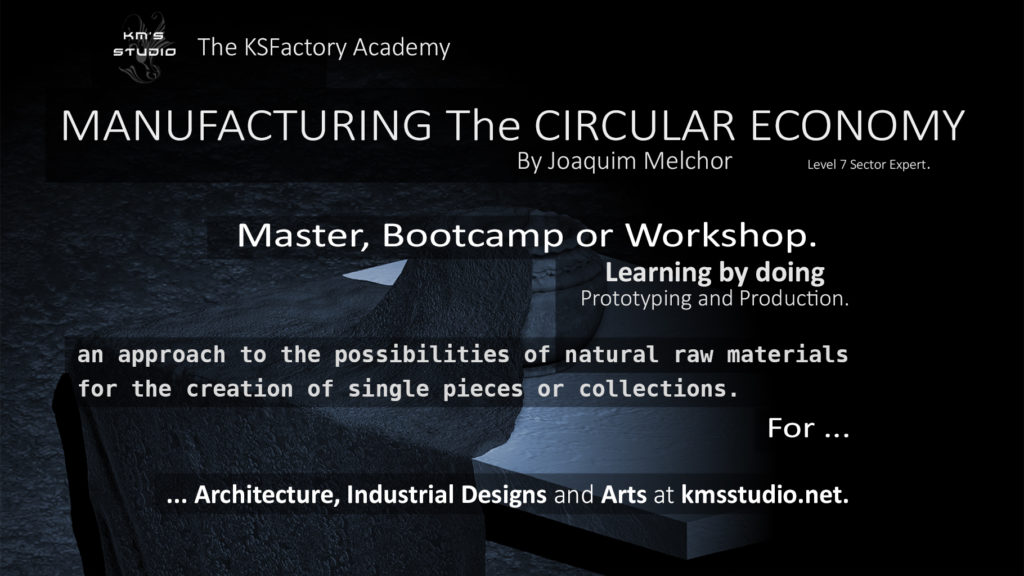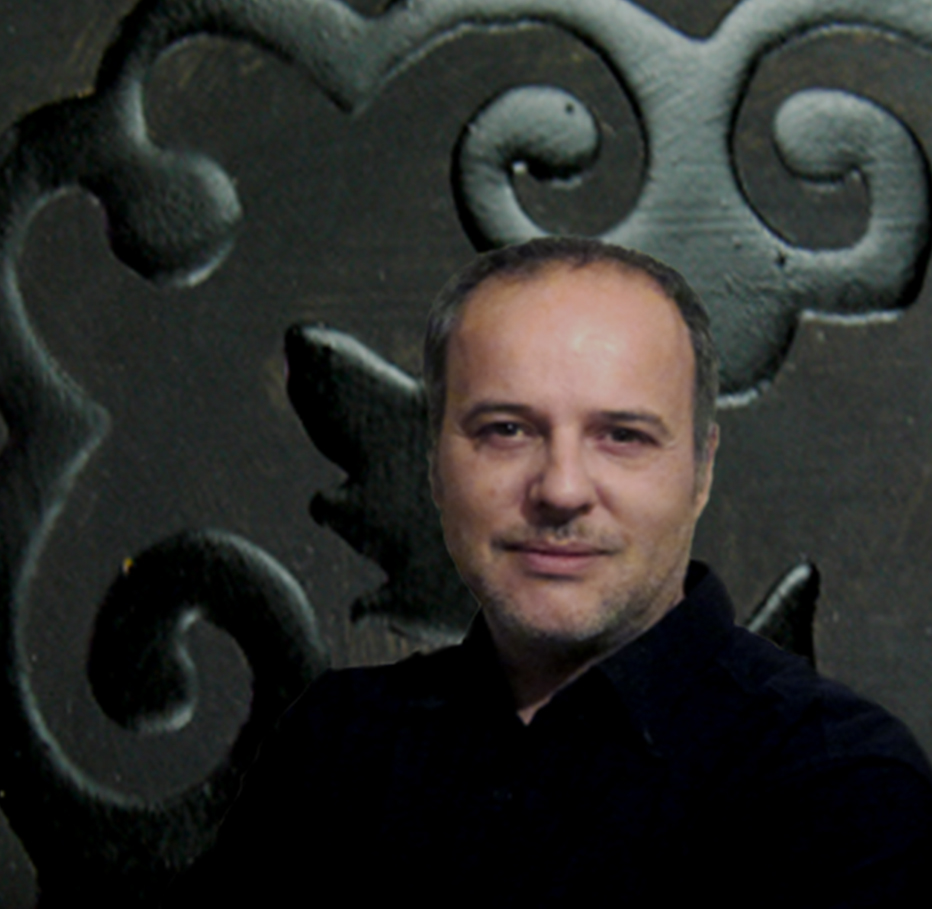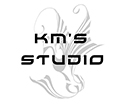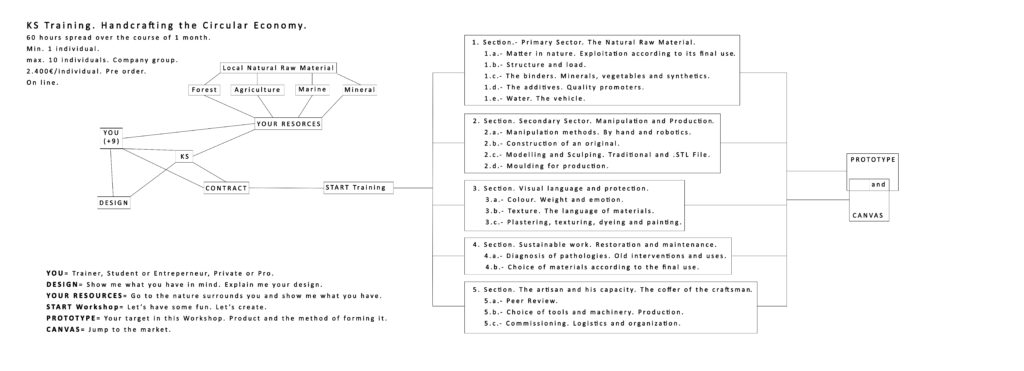
Provision of professional training services under title, “MANUFACTURING THE CIRCULAR ECONOMY” (MCE).

Directed by:
- Joaquim Melchor Rojas. CEO at Km’s Studio.
- ID.- 40522119Y
- Level 3 Professional Competences for Labor by Spanish Ministry of Education and Professional Training. Link to certification.
- Level 7 Sector Expert in Cultural Learning and Creative Business Development and Support per SQF with 96 ECTS Credits. Link to certification.
- 37 years of field experience in the creation with natural materials and professional training (link to Spanish affidavit).
- https://www.linkedin.com/in/joaquim-melchor/
- EUROPASS
CONCEPT.
Manufacturing the Circular Economy, is an intensive course designed from the point of view of the maker who directs, or will direct, a small or medium-sized company destined to manufacture or apply construction solutions based on the use of natural materials. This company would operate in the field of application of the Arts of Architecture and its related disciplines.
The training prescribed at MCE is the consequence of the research developed at Km’s Studio through its R&D department, whose mission is to create content, prototypes and demonstrative examples.
At MCE we will show the necessary methodology to undertake different production systems and solve contingencies that affect the process of concept, design, production and implementation in the market because, if you know how things are done…
- … You will design better. To the creative. The sensory experience of working with natural material nourishes your senses with very valuable information, in a way that no other format can offer you, so you can design solutions that are more coherent with the needs of the market.
- … You will produce better. To the manufacturer. Knowing the methods of transforming matter into a work will give you a problem-solving capacity that will allow you to undertake different systems in an agile way, according to your business expectations.
- … You will buy better. To the end customer. If you are interested in biophilia, or identifying with a natural language, knowing the process by which the work reaches your most intimate environment will help you make an objective decision that is more in line with your needs.
The methodology shown in HCE is based on a common thread that begins with the study and knowledge of the methods of restoration of artistic and architectural heritage to adapt them to current demands, implementing new technologies to aid the production and creation of products and modern consumer goods.
GOAL.
Transfer to different geographies, or economic regions, knowledge about the design and application of the methodology based on the diagnosis and use of natural resources, including forestry, agricultural, marine and mineral waste, for the manufacture of products and consumer goods. destined for the local economy.
GENERAL CHARACTERISTICS.
- The course consists of twenty-two chapters integrated into five blocks that are taught according to the “Learning by doing” pedagogical method, pivoting on the manufacture of a prototype or demonstrative example based on the use of natural resources, including forestry, agricultural, marine and minerals.
- The course offers a common thread that unites traditional manual methods as the basis of learning to later add current technological aids to support production, according to the commercial expectations reflected in a business plan model “Canvas”.
- The solutions provided comply with 11 of the 17 SDGs proposed by the UN, given that they work on the idea that the Circular Economy depends on the Local Circular Economy.
- Students must receive training applied to the three sectors of production, that is, the diagnosis and exploitation of natural resources according to an established design. The manipulation of natural matter to produce a product or consumer good, and the implementation of the product in the market.
- The scope of the social impact of the solutions provided must have an international scope.
- The course has been expressly designed to adapt to the specific needs of each case or format.
- The proposed solutions, if implemented in the socioeconomic-cultural context, meet 11 of the 17 SDG purposes by the UN.
- “Post-course” Service. This service is necessary for students, and their companies, to implement their solutions in the market, acquire regularity in the quality of their projects based on what is prescribed in the HCE.
PROGRAMS.
- MASTER for trainers and active faculty management, private or in schools and organizations dedicated to teaching architecture, engineering and arts and crafts. This option is a priority as a way of having the greatest social impact.
- Duration between one and three months. 60 hours Online + 60 hours in the workshop. Maximum 3 students.
- Price of €6,000 per student, including material and subsistence allowance if taking the workshop at the KS facilities.
- Price on request for the optional certification as Level 7 Sector Expert in cultural learning and cultural business support and development (96 ECTS credits).
- Training BOOTCAMP for future professionals studying architecture, interior design, industrial design, arts and crafts, engineering and VET.
- Duration of one month. 10 hours Online + 60 hours in the workshop. Maximum 10 students.
- Price of €3,000 (€300 per student), including material and subsistence allowance if taking the workshop at the KS facilities.
- Price on request for the optional certification as Level 7 Sector Expert in cultural learning and cultural business support and development (96 ECTS credits).
- Training WORKSHOP for active professionals who require specialization in the use or application of natural materials in the field of restoration, maintenance and adaptation of Romanesque, Islamic and modernist heritage.
- Duration of 60 h in the Workshop. Maximum 10 students.
- Price of €3,000 (€300 per student), taking the workshop in facilities other than those of KS.
- Price upon request for the optional certification as Level 4 to 7 Sector Expert (ECTS credits).
AREAS OF EXPERTISE.
- Restoration of architectural heritage as an essential part of the HCE course as it provides basic information on the diagnosis, compilation and traditional transformation of the subject.
- Interior architecture or interior design transferring the language and texture of nature into our most intimate environment. Biophilia.
- Industrial Design for nautical, demonstrating that natural material can acquire stable forms in permanent contact with water, thanks to the use of modern technology to aid the production chain.
- Arts and Crafts creating original pieces and collections of objects or elements with which we will feel identified.
PROTOCOL.
- 0.- Pre-contract for the services that ensures the availability of both parties for the proper execution of the following processes.
- 1.- Specification of the product designed to assess its viability according to the possibilities of the materials. The student presents a draft of the design to be prototyped with sufficient graphic details for the understanding of the project and thus establish the product design study.
- 2.- Study of the Local Natural Raw Material to diagnose its characteristics and behavior prior to the completion of the course. The student must do field work locating the natural resources of their geographic area to collect them selectively.
- Type of Natural Matter to be studied:
- Corresponding to plants such as algae, shrubs, tree barks and shells, fatty acids such as resins, oils, waxes and turpentine, and cereals such as wheat, rice, sorghum, etc. Including agricultural, marine and forestry waste.
- Corresponding to the mineral group: all types of non-metallic minerals. Including mineral waste.
- 3.- Contract for the services if the result of the study of possibilities favors the development of the course.
- 4.- Conduct of HCE Training according to the following organization:
- Design introduction and display.
- Location, diagnosis and capture of natural resources.
- Preparation of compounds.
- Manufacturing methodology.
- Production of the prototype or example case.
- Restoration and maintenance.
- Promotion and implementation in the market.
- 4.a.- Documentation to be generated by the student:
- Analogies between the manual and industrial methods used in the manufacture of your example.
- Traceability of the material until its transformation into a final product according to the intervention process in the three sectors of the production chain.
- Primary Sector.- Exploitation of natural resources.
- Secondary Sector.- Manipulation and composition of matter to manufacture and produce a design or shape.
- Tertiary Sector.- Marketing.
- 5.- Development of Canvas Business Plan according to the Sustainable Development Goals indicated by the UN.
- 6.- Development of a basic WordPress web page.
SUMMARY.
- 1. Section.- Primary Sector. The Natural Raw Material.
- 1.a.- Matter in nature. Exploitation according to its final use.
- 1.b.- Structure and load.
- 1.c.- The binders. Minerals, vegetables and synthetics.
- 1.d.- The additives. Quality promoters.
- 1.e.- Water. The vehicle.
- 2. Section. Secondary Sector. Manipulation and Production.
- 2.a.- Manipulation methods. By hand and robotics.
- 2.b.- Construction of an original.
- 2.c.- Modelling and Sculpting. Traditional and .STL File.
- 2.d.- Molding for production.
- 3. Section. Visual language and protection.
- 3.a.- Color. Weight and emotion.
- 3.b.- Texture. The language of materials.
- 3.c.- Plastering, texturing, dyeing and painting.
- 4. Section. Sustainable work. Restoration and maintenance.
- 4.a.- Diagnosis of pathologies. Old interventions and uses.
- 4.b.- Choice of materials according to the final use.
- 4.c.- Commissioning. Logistics and Organization.
- 5. Section. The maker.
- 5.a.- The state of your art.
- 5.b.- Innovation.
- 5.c.- Sharing expertise.
- 5.d.- Social impact.

